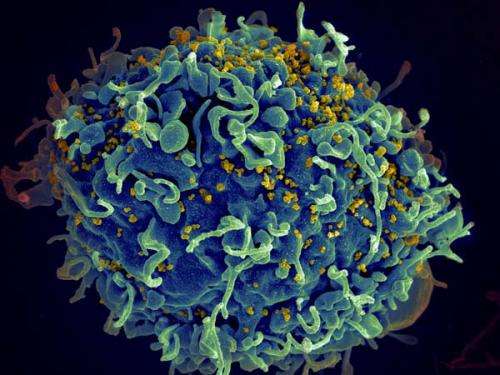Scientists reawaken sleeping HIV in patient cells to eliminate the virus

A consortium of investigators led by scientists at Sanford Burnham Prebys Medical Discovery Institute (SBP) have found that a new class of drugs may be used to purge pockets of dormant HIV from a patient's body, eliminating the virus once and for all. Since these agents are already being explored in clinical trials for treating cancer, the route to approval for treating HIV may be significantly shorter than usual.
Antiretroviral therapies have made it possible for people to live with HIV for decades. However, patients continue to harbor small and persistent reservoirs of cells that hide the virus. That is, HIV's genes live in the cells, but its genetic code is never read to make protein, and so the virus goes undetected by the immune system.
"If you take people off their antiretroviral therapies, some of these dormant cells reawaken to make more virus and re-establish disease," said lead author Lars Pache, Ph.D., a postdoctoral fellow in the lab of Sumit Chanda, Ph.D., director of the Immunity and Pathogenesis Program at SBP. "The key for a cure for HIV is to purge these cells that have dormant HIV."
Reactivating latent HIV-infected cells so that they can be killed off is called a shock-and-kill approach. The approach has remained elusive so far, because candidate drugs that reawaken the virus, known as latency reversing agents (LRAs), appear to lack sufficient potency, or alternatively, could trigger massive immune system activation, which itself could be deadly.
The new study, published September 9 in the journal Cell Host & Microbe, "uses a class of drug called Smac mimetics to tap into a molecular backdoor, a cell pathway that can be used as an intense alarm to wake up the virus, but doesn't appear to activate the immune system," Chanda said.
The study started with a broad search of genes within the host cells that help suppress the virus. They found that the absence of one gene in particular, BIRC2, boosted the activity of HIV, and Smac mimetics—already proven safe in early-stage clinical trials for cancer—work by inhibiting BIRC2 and related molecules.
"These experiments led us to develop a strategy of using Smac mimetics to reawaken dormant HIV so that it can be detected by the immune system and purged," explained Chanda.
Chanda's colleague at SBP, Nicholas Cosford, Ph.D., professor in the Cell Death and Survival Networks Program, had recently identified a potent BIRC2 inhibitor, SBI-0637142. "Although there are clinical- stage Smac mimetics available, they were not specifically developed for HIV-1 treatment. Our internal drug possesses about 10-100 times more potent LRA activity than the small molecules currently in clinical development, making it a promising next-generation candidate to tackle HIV latency," says Chanda.
Part of the reason that HIV's genes stay hidden in its host is that they cover themselves with tightly wound DNA. A class of drugs called histone deacetylase inhibitors, which unfurls the DNA, is used to treat a variety of conditions. Although most of these inhibitors haven't thus far worked well on their own to reactivate latent HIV, they might work well with Smac mimetics including SBI-0637142, Chanda's group reasoned.
The key question was whether they could reactivate the virus in cells from HIV-infected patients undergoing antiretroviral therapy. They combined SBI-0637142 with a histone deacetylase inhibitor (panobinostat) and saw signs that the virus had reawakened without triggering immune activation.
"We anticipated that we would see a synergy because the drugs work along parallel pathways. What we didn't expect was the level of activation and the efficacy with which we were able to reverse latency in patient samples," Chanda said.
They saw similar results in patient cells treated with a combination of LCL161—a Smac mimetic that is already in phase 1 and 2 trials for treating cancer—and panobinostat. "This is a one-two punch for HIV," said Chanda, adding that ultimately, a cocktail of drugs will likely be necessary to cure HIV.
The scientists hope to partner with a pharmaceutical company to develop these molecules for evaluation in clinical models of HIV latency and then move them into human testing if they meet the safety and efficacy criteria.
















